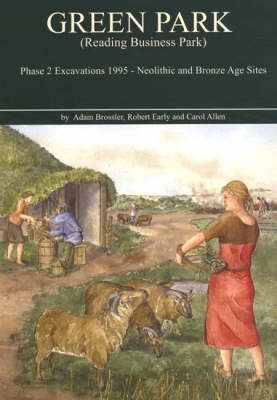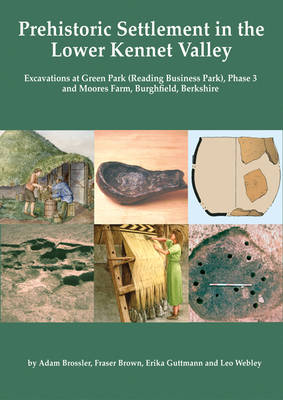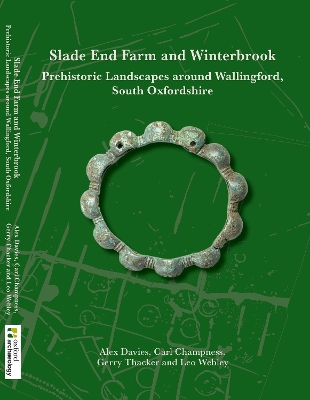Thames Valley Landscapes Monograph
3 primary works
Book 19
Green Park (Reading Business Park) Phase 2 Excavations 1995
by Carol Allen, Adam Brossler, and Robert Early
Published 17 January 2004
In 1995 a second phase of excavations was undertaken by Oxford Archaeological Unit (OAU) at Reading Business Park in advance of development. This volume reports on the occupation evidence they found dating to the Neolithic, Bronze Age and medieval periods. The Neolithic features included an unusual segmented ring ditch, and a number of pits and postholes, with associated flint assemblages dating to the late Neolithic. A field system, composed of rectangular boundary ditches, was laid out in the area prior to the establishment of the late Bronze Age settlement. The evidence for the late Bronze Age settlement included five roundhouses, and a number of post-built structures. The excavators also found numerous deposits of burnt flint that were made in one area in the later Bronze Age, and over time these grew into a substantial and unusually large elongated burnt mound. The authors discuss the origin of these deposits, together with the management of the overall landscape in the later Bronze Age.
Book 37
Prehistoric Settlement in the Lower Kennet Valley
by Adam Brossler, Fraser Brown, Erika Guttman, and Leo Webley
Published 31 July 2013
This volume presents the results of two excavations on the gravel terraces of the Lower Kennet Valley, at Green Park (Reading Business Park) Phase 3 and Moores Farm, Burghfield, Berkshire.
The Green Park excavations uncovered a field system and occupation features dating to the middle to late Bronze Age. Five waterholes or wells were distributed across the field system, the waterlogged fills of which preserved wooden revetment structures and valuable environmental evidence. The pottery from the waterholes makes a significant contribution to our understanding of the middle to late Bronze Age transition in the region. Later activity included middle to late Iron Age boundaries, a late Iron Age cremation burial, a Romano-British field system and post-medieval trackways.
The Moores Farm excavations revealed occupation from the Mesolithic, Neolithic, middle Bronze Age and early Iron Age. The middle Bronze Age settlement included pits, ovens and possible post structures, and was again situated within a contemporaneous field system dotted with waterholes.
As well as discussing these two sites, the volume provides an overview of all of the work to date in the Green Park Farm/Reading Business Park area, exploring the development of this important prehistoric landscape.
The Green Park excavations uncovered a field system and occupation features dating to the middle to late Bronze Age. Five waterholes or wells were distributed across the field system, the waterlogged fills of which preserved wooden revetment structures and valuable environmental evidence. The pottery from the waterholes makes a significant contribution to our understanding of the middle to late Bronze Age transition in the region. Later activity included middle to late Iron Age boundaries, a late Iron Age cremation burial, a Romano-British field system and post-medieval trackways.
The Moores Farm excavations revealed occupation from the Mesolithic, Neolithic, middle Bronze Age and early Iron Age. The middle Bronze Age settlement included pits, ovens and possible post structures, and was again situated within a contemporaneous field system dotted with waterholes.
As well as discussing these two sites, the volume provides an overview of all of the work to date in the Green Park Farm/Reading Business Park area, exploring the development of this important prehistoric landscape.
Book 46
Slade End Farm and Winterbrook
by Alex Davies, Carl Champness, Gerry Thacker, and Leo Webley
Published 14 June 2024
This volume reports on two excavations carried out by Oxford Archaeology on the outskirts of Wallingford, at Slade End Farm and Winterbrook. The two sites provide windows into the same gravel terrace landscape and together shed significant new light on the prehistory of the south Oxfordshire Thames Valley.
Slade End Farm was repeatedly visited for settlement in the early Neolithic. Numerous clusters of pits were found that contained pottery, flintwork and other finds. A pair of inhumation
burials was also discovered. Sparser settlement subsequently occurred at the two sites during the middle and late Neolithic and the Beaker period.
Landscape organisation dramatically changed in the middle Bronze Age, when ditched field systems or enclosure complexes were laid out at both sites. A waterhole containing a log ladder was also found. Environmental evidence suggests a landscape of largely open grassland used for grazing. While no buildings were found, concentrations of finds in some enclosures suggest that they were foci for domestic activity. Several burials were also found at each site.
Both sites were reoccupied for settlement during the early and middle Iron Age. Roundhouses were built, and a series of boundaries and enclosures laid out. A double pit alignment dug in the early Iron Age at Slade End Farm separated the occupied area from the lower, wetter ground to the south. One of the pits from this alignment contained an inhumation burial. A complete, decorated copper alloy bracelet that had been placed in a posthole is a rare survival.
At Winterbrook, part of a settlement dating to the 11th to 12th centuries was also uncovered, providing the first good archaeological evidence for a rural community in the immediate hinterland of the medieval town of Wallingford.
Slade End Farm was repeatedly visited for settlement in the early Neolithic. Numerous clusters of pits were found that contained pottery, flintwork and other finds. A pair of inhumation
burials was also discovered. Sparser settlement subsequently occurred at the two sites during the middle and late Neolithic and the Beaker period.
Landscape organisation dramatically changed in the middle Bronze Age, when ditched field systems or enclosure complexes were laid out at both sites. A waterhole containing a log ladder was also found. Environmental evidence suggests a landscape of largely open grassland used for grazing. While no buildings were found, concentrations of finds in some enclosures suggest that they were foci for domestic activity. Several burials were also found at each site.
Both sites were reoccupied for settlement during the early and middle Iron Age. Roundhouses were built, and a series of boundaries and enclosures laid out. A double pit alignment dug in the early Iron Age at Slade End Farm separated the occupied area from the lower, wetter ground to the south. One of the pits from this alignment contained an inhumation burial. A complete, decorated copper alloy bracelet that had been placed in a posthole is a rare survival.
At Winterbrook, part of a settlement dating to the 11th to 12th centuries was also uncovered, providing the first good archaeological evidence for a rural community in the immediate hinterland of the medieval town of Wallingford.


